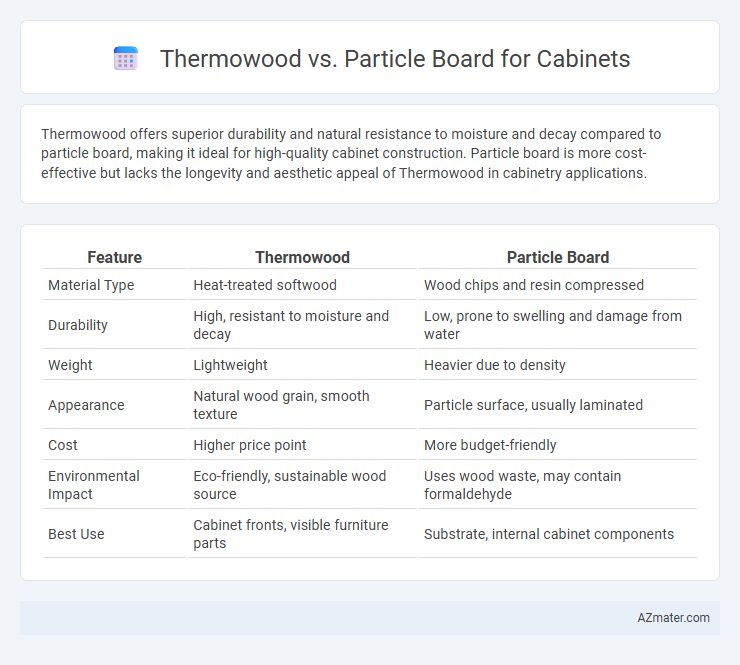Thermowood offers superior durability and natural resistance to moisture and decay compared to particle board, making it ideal for high-quality cabinet construction. Particle board is more cost-effective but lacks the longevity and aesthetic appeal of Thermowood in cabinetry applications.
Table of Comparison
| Feature | Thermowood | Particle Board |
|---|---|---|
| Material Type | Heat-treated softwood | Wood chips and resin compressed |
| Durability | High, resistant to moisture and decay | Low, prone to swelling and damage from water |
| Weight | Lightweight | Heavier due to density |
| Appearance | Natural wood grain, smooth texture | Particle surface, usually laminated |
| Cost | Higher price point | More budget-friendly |
| Environmental Impact | Eco-friendly, sustainable wood source | Uses wood waste, may contain formaldehyde |
| Best Use | Cabinet fronts, visible furniture parts | Substrate, internal cabinet components |
Introduction to Thermowood and Particle Board
Thermowood is a type of heat-treated wood known for its enhanced durability, stability, and resistance to moisture and decay, making it an excellent choice for cabinetry in humid environments. Particle board consists of wood chips, sawdust, and resin compressed into sheets, offering an affordable and smooth surface ideal for painted or laminated cabinet finishes. Comparing Thermowood and particle board highlights differences in longevity, environmental resistance, and structural strength crucial for cabinet construction.
Material Composition and Manufacturing Processes
Thermowood is produced by heat-treating softwood lumber, such as pine or spruce, at temperatures between 160-220degC to enhance durability and dimensional stability through chemical changes in the wood fibers. Particle board consists of wood particles and resins compressed under high pressure and heat, creating a dense, engineered panel with lower moisture resistance compared to Thermowood. The thermal modification in Thermowood reduces hygroscopicity and increases resistance to decay, while particle board relies on adhesives like urea-formaldehyde to bind particles, impacting environmental and performance characteristics in cabinet applications.
Durability and Longevity Comparison
Thermowood offers superior durability compared to particle board due to its enhanced resistance to moisture, decay, and insect damage, making it ideal for long-lasting cabinet construction. The thermal modification process improves wood stability and reduces swelling, ensuring that Thermowood cabinets maintain structural integrity over time. Particle board, while cost-effective, tends to degrade quickly when exposed to humidity or heavy use, resulting in shorter lifespan and frequent repairs.
Moisture and Heat Resistance
Thermowood offers superior moisture and heat resistance compared to particle board due to its heat-treated process that enhances durability and dimensional stability. Particle board tends to absorb moisture easily, leading to swelling and weakening, making it less ideal for kitchen cabinets exposed to humidity and temperature fluctuations. Choosing Thermowood ensures longevity and reliable performance in environments subject to steam, heat, and moisture exposure.
Aesthetic Appeal and Surface Finishing
Thermowood offers a rich, natural grain pattern with enhanced durability, providing cabinets a premium aesthetic appeal compared to the uniform, mass-produced look of Particle Board. Its surface finishing accommodates stains and paints effectively due to the modified wood fibers, resulting in long-lasting, smooth finishes that resist moisture and decay. Particle Board typically requires veneers or laminate overlays to achieve a decorative look, often lacking the authentic texture and longevity that Thermowood naturally delivers.
Environmental Impact and Sustainability
Thermowood, produced through a heat treatment process that enhances durability without chemicals, offers a sustainable option with reduced environmental impact compared to particle board. Particle board relies on adhesive resins containing formaldehyde and often uses recycled wood fibers, which can emit harmful VOCs and pose disposal challenges. Choosing Thermowood supports eco-friendly cabinetry by combining longevity, lower emissions, and responsible forestry practices.
Cost Effectiveness and Value for Money
Thermowood offers superior durability and resistance to moisture compared to particle board, resulting in longer-lasting cabinets with less maintenance. While particle board is initially cheaper, Thermowood's higher upfront cost provides greater value for money through enhanced lifespan and aesthetic appeal. Investing in Thermowood cabinets reduces replacement frequency, making it a cost-effective choice for quality-conscious homeowners.
Ease of Workability and Customization
Thermowood offers superior workability compared to particle board due to its stable structure and uniform density, allowing for precise cutting, drilling, and shaping without excessive splintering. Its natural wood composition enables easier customization with stains, paints, and finishes, resulting in durable and aesthetically pleasing cabinets. Particle board, while cost-effective, tends to chip and swell under moisture, limiting its versatility and making intricate customization more challenging.
Common Applications in Cabinet Making
Thermowood is commonly used in high-end cabinetry due to its enhanced durability, moisture resistance, and natural aesthetic, making it ideal for kitchen and bathroom cabinets exposed to humidity. Particle board is frequently chosen for economical cabinet interiors and shelving because of its low cost and smooth surface, which is well-suited for veneer or laminate finishes. Both materials serve distinct purposes in cabinet making, with Thermowood preferred for structural and exterior elements and Particle board favored for cost-effective, lightweight applications.
Conclusion: Choosing the Right Material for Your Cabinets
Thermowood offers superior durability, moisture resistance, and natural resistance to decay, making it ideal for long-lasting, high-quality cabinets in humid environments. Particle board provides a cost-effective, lightweight option with smooth surfaces ideal for laminated finishes but lacks the strength and moisture resistance of Thermowood. Selecting the right material depends on budget constraints, desired cabinet lifespan, and exposure to moisture, with Thermowood favored for premium, moisture-prone settings and particle board suitable for budget-friendly, low-moisture applications.

Infographic: Thermowood vs Particle Board for Cabinet
 azmater.com
azmater.com